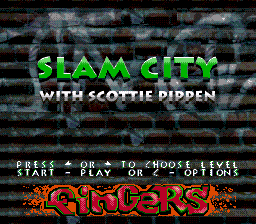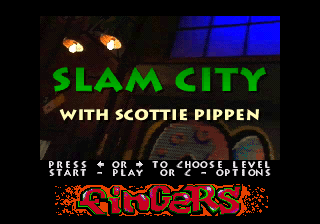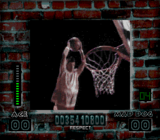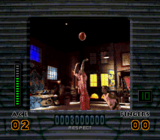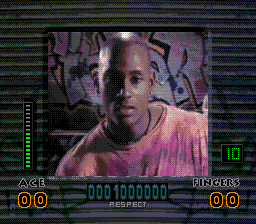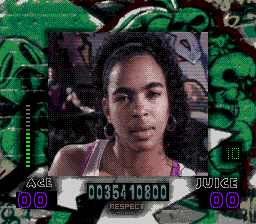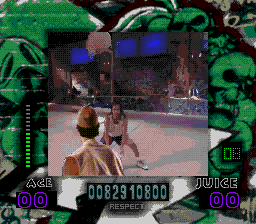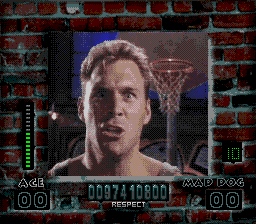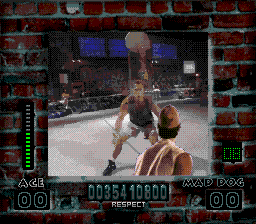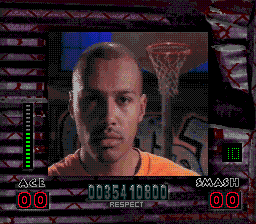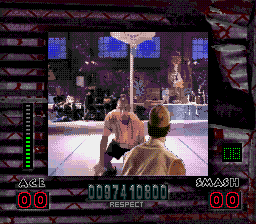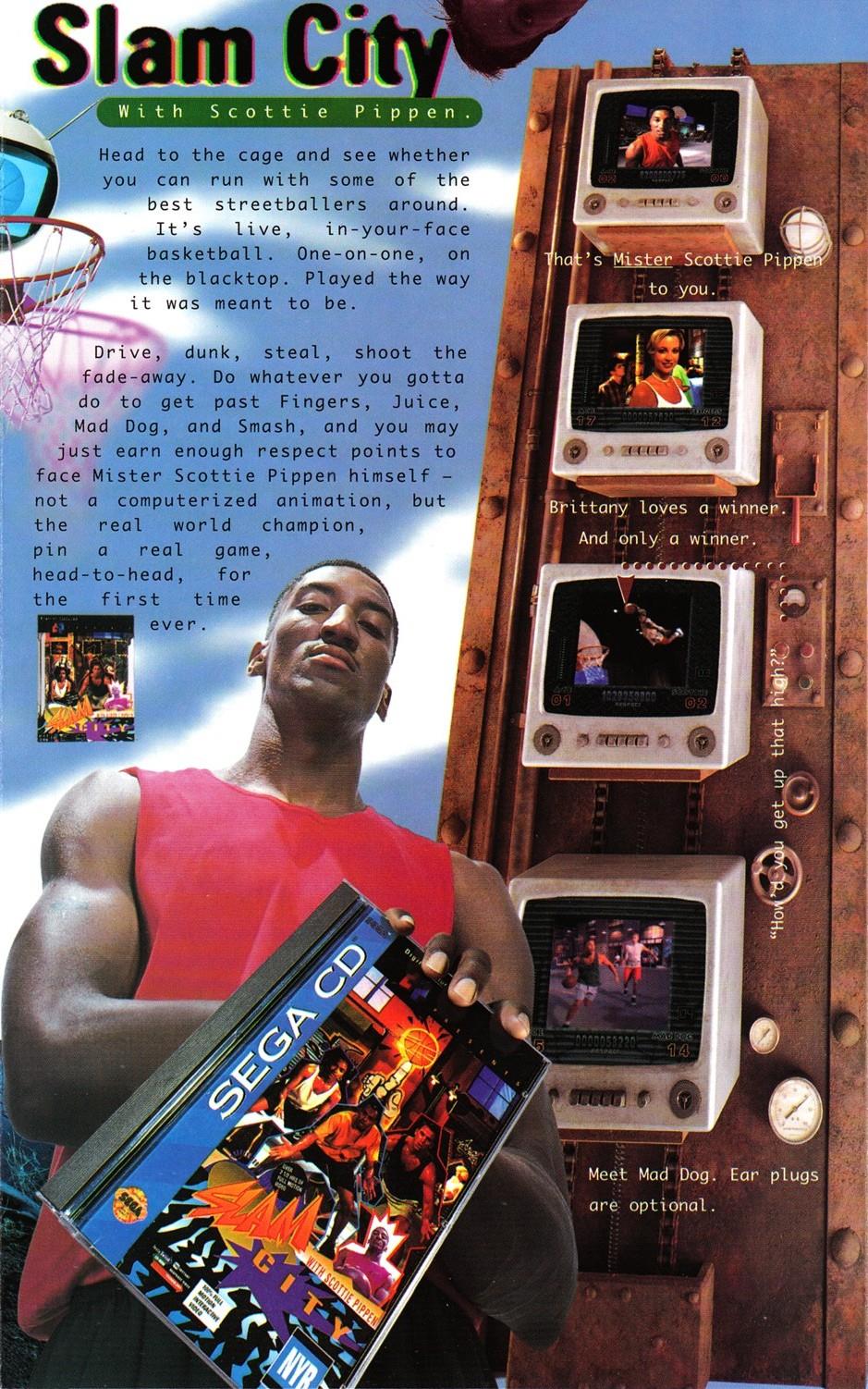Slam City with Scottie Pippen is a full-motion video game developed and published by Digital Pictures for the Sega Mega-CD and DOS computers. It was also one of the five Sega Mega-CD 32X games released in North America. It features NBA player Scottie Pippen, who played small forward for the Chicago Bulls at the time.
Gameplay
Slam City is a one-on-one basketball game, presented from a first-person perspective using full-motion video. The player plays a newcomer named "Ace" and must face the four toughest players in "Slam City" to earn enough "respect" to play against Scottie Pippen. The game is spread over four discs, with each of the first four opponents on a separate disc. Matches are interjected with video clips of "trash talk" from the opponents or commentary from spectators.
Matches consist of multiple video clips of the opponent, and the player must respond appropriately to the opponent's actions, such as defending against attempts to steal the ball or exploiting weaknesses in the opponent's defense to attempt a shot or a slam. Ace appears overlaid on the video. The goal of each match is to earn more points than the opponent, and every basket is worth a single point. By default, the first player to reach seven points wins, though this can be changed.
Respect is earned during games by scoring, blocking shots, stealing the ball, rebounding the ball (after a missed shot), or running down the opponent's shot clock. Respect is also gained after beating an opponent, with more respect gained when the score disparity is greater. Conversely, respect is lost when the opponent scores, blocks a shot, steals the ball, rebounds the ball, runs down the Ace's shot clock, or beats Ace. Tougher opponents award more respect. Opponents can be rematched to earn more respect, but the amount of respect earned decreases each time the opponent is played.
When on offense, Ace can move with  or
or  to try to get a clear shot around his opponent. The player can adjust the shot strength (shown as a meter next to the video) with
to try to get a clear shot around his opponent. The player can adjust the shot strength (shown as a meter next to the video) with  or
or  , which affects the distance that it covers. Ace shoots by holding
, which affects the distance that it covers. Ace shoots by holding  to jump, then releasing
to jump, then releasing  during the jump. The shot is more likely to go in and earns more respect if timed to release near the apex of the jump. Failing to release the button before landing causes the player to lose respect. Ace can exploit holes in the opponent's defense by moving all the way to the left or right of the screen and pressing
during the jump. The shot is more likely to go in and earns more respect if timed to release near the apex of the jump. Failing to release the button before landing causes the player to lose respect. Ace can exploit holes in the opponent's defense by moving all the way to the left or right of the screen and pressing  to break past the opponent and perform a slam dunk. Each opponent has different cues that indicate a break opportunity. Hitting a break opportunity at its "sweet spot" results in a "Super Slam" that awards more respect. However, trying to break past the opponent when there is no opening results in having the ball stolen. There is a ten-second shot clock for the player with possession of the ball.
to break past the opponent and perform a slam dunk. Each opponent has different cues that indicate a break opportunity. Hitting a break opportunity at its "sweet spot" results in a "Super Slam" that awards more respect. However, trying to break past the opponent when there is no opening results in having the ball stolen. There is a ten-second shot clock for the player with possession of the ball.
When on defense, Ace can move with  or
or  to stay in front of his the opponent. If Ace leaves an opening, the opponent can run by for an easy shot. Ace can raise his hands to block with
to stay in front of his the opponent. If Ace leaves an opening, the opponent can run by for an easy shot. Ace can raise his hands to block with  when the opponent is attempting a shot; after the opponent shoots, Ace can try to reject the shot with
when the opponent is attempting a shot; after the opponent shoots, Ace can try to reject the shot with  . When the opponent is trying to break for a dunk, Ace can try to steal the ball with
. When the opponent is trying to break for a dunk, Ace can try to steal the ball with  .
.
When either Ace or the opponent misses a shot, the screen switches to a side view where both opponents have an opportunity for a rebound to gain possession of the ball. In the rebound view, Ace can move with  or
or  and jump for the ball with
and jump for the ball with  .
.
Enabling Training Mode in the options shows the word "BREAK" on screen to indicate when a slam dunk opportunity is present on offense or an opportunity to steal the ball is present on defense, to help the player learn the vulnerabilities of the opponent. However, respect cannot be gained or lost while Training Mode is enabled. Enabling Buckets Mode in the options lets the offensive player retain possession of the ball after scoring (winners' outs) rather than possession changing to the player on defense (losers' outs). Games can be played to a certain number of points (7, 11, or 21) or timed (3 or 5 minutes). In timed games, the winner is whichever played has the most points when time runs out; if there is a tie, the game goes into "sudden death," where the next player to score wins. The game saves the player's progress and high scores to the console's internal memory.
Opponents
Opponents can be challenged in any order, except for Scottie Pippen, who can only challenged after accumulating 1,000,000,000 respect points. Each opponent increases in difficulty and respect earned. Matches can be replayed to earn more respect.
Fingers is on the first disc, Juice is on the second disc, Mad Dog is on the third disc, and Smash is on the fourth disc. Scottie Pippen is on every disc but must be unlocked first.
|
|
Fingers
|
|
|
|
|
Juice
|
|
|
|
|
Mad Dog
|
|
|
|
|
Smash
|
|
|
|
|
Scottie Pippen
|
|
|
Production credits
- Executive Producer: Tom Zito, Tyler Johnson
- : Keith Neubert, Antwahn Nance, Dana Wilkerson, Malcolm Ian Cross, Keith Gibbs
- Interactive Design: Kevin Welsh, Steve DeFrisco
- Computer Programming: Steve DeFrisco
- Editing: Kate McGowen
- Screenplay: Don Scott
- Director of Photography: Paul McIlvaine
- Production Design: Nick Goodman
- Produced by: Gordon Wolf, Kevin Welsh
- Directed by: Ron Stein
Source: In-game credits (opening)[5]
Cast
- Ace: Keith Gibbs
- Fingers: Malcolm Ian Cross
- Mad Dog: Keith Neubert
- Juice: Dana Wilkerson
- Smash: Antwahn Nance
- Brittany: Louise Bjerregaard
- Smooth: Cyrus Farmer
- Sheila: Asha Siewkuar
- Dolla' Bill: Doug McDonald
- G-Man: Abdul Salaam El Razzac
- Malik: Anthony Hall
- Jeff: David Wagner
- Stunts: Keith Rooks, Brian Smith
- Stunt and Basketball Coordinator: Steve "Buck" Buckingham
- Assistant Coordinator: Charles Norman
- Production Coordinator: Anna-Lisa Nilsson
- Associate Producer: Shari Little
- Computer Graphics: James Kasanin, Joshua Solomon, Kim Tempest
- 1st Assistant Director: Michael Klick
- 2nd Assistant Director: Stephen Maddocks
- Script Supervisor: Kate Morrison
- Camera Operator: Eyal Gordin
- Video Technician: Alan B. Porter
- Assistant Art Director: Carole Cooke
- Art Assistants:' Ron Kurash, Damian Michael "Mark" Blower
- Prop Master: John Richards
- Art Production Assistant: Randy Villanueva
- Costume Design: Dorothy Amos
- Costume Supervisor: Paul Girard
- Set Costumers: Eileen Dunn, Sheila Streicek
- Make-Up Artist: Janetta Stowers
- Key Hair Stylist: Linda Stevenson-Khan
- Gaffer: Daryl "Dazz" Reynolds
- Best Boy Electric: Bobby Wotherspoon
- Electricians: Darrin Porter, Steve Cooke
- Key Grip: Dave Michels
- Best Boy Grip: Dave Bodin
- Grips: Chi Michela, Dylan Shephard, Mark Pickens, Reid Freeman
- Sound Mixer: Steuart Pearce
- Boom Operator: Gunnar Walter
- Production Accountant: Tad Driscoll
- Assistant Accountant: Richard Flemming
- Location Manager: Mike Jarvis
- Casting Basketball Players: Rob Ryder
- Remaining Cast: Sobo Casting
- Extra Casting: Cheryl Faye
- Still Photography: Peter Iovino
- Production Assistants: Charlie Coffey, Anna Thrappas, Dana Stein
- Craft Service: Bobby Rodriguez
- Paramedics: Jennifer Mielziner, Robert Foster
- Massage Therapists: Amy Cadiente, Jill Nseir
- Post Production Supervisor: Eric Valente
- Assistant Editor: Jennifer Mangan
- Online Editor: Marty Rosenstalk
- Tape Operator: Brian Morefield
- Colorist: Ed Rowan
- Sound Design: Chris Trent
- Sound Editor/Mixer: Mick Brooling
- Head Tester: David Popovich
- Lead Tester: Jason White
- Testers: Richard Wong, Mark Vitello, Karl Frese, Paul Franco
- Product Assistant: Bart Cheever
- Main Title Theme "Respect" (Theme from Slam City)
- Performed by Scottie Pippen
- produced by Jellybean Benitez for Jellybean Productions, Inc.
- Written by Jellybean, Ed Terry, Kangol
- Published by House of Fun Music, Inc (BMI) and Lost In Music Inc. (ASCAP)
- BMI Administered by Jellybean Publishing Group
- © 1994 Digital Pictures, Inc.
- Game Music: Mark Miller's Neuromantic Productions
- Composed by: John Baker
- © 1994 Digital Pictures, Inc.
- Ownership of this interactive U-Direct motion picture is protected by copyright, trademark, patent, and other applicable laws. Any unauthorized duplication, distribution, or exhibition of this interactive U-Direct motion picture could result in criminal prosecution as well as civil liability.
- Slam City with Scottie Pippen uses Digital Pictures' patent pending InstaSwitch technology. Digital video captured using Digital Pictures' DigiChrome process.
- Slam City with Scottie Pippen is a trademark of Digital Pictures, Inc. DigiChrome and U-Direct are registered trademarks of Digital Pictures, Inc. InstaSwitch is a trademark of Digital Pictures, Inc.
- Slam City with Scottie Pippen was created, produced and published by Digital Pictures, Inc.
- © 1994 Digital Pictures, Inc. All Rights Reserved.
Source: In-game credits (ending)[6]
- Executive Producers: Tom Zito, Tyler Johnson
- Original Concept: Kevin Welsh
- Interactive Design: Kevin Welsh, Steve DeFrisco
- Opening Theme Music Performed by: Scottie Pippen
- Produced by: Jellybean Benitez
- Written by: Jellybean, Ed Terry, and Kangol
- Game Music: Neuromantic Productions
- Composer: John Baker
- Editing: Kate McGowen
- Production Design: Nick Goodman
- Director of Photography: Paul McIlvaine
- Screenplay: Don Scott
- Computer Programming: Steve DeFrisco
- Produced by: Gordon Wolf, Kevin Welsh
- Directed by: Ron Stein
- Associate Producer: Shari Little
- Computer Graphics: James Kasanin, Kim Tempest, Joshua Solomon
- Lead Tester: David Popovich
- Package & Manual: The Design Office of Wong & Yeo
Cast
- Scottie Pippen: Himself
- Fingers: Malcom Ian Cross
- Juice: Dana Wilkerson
- Mad Dog: Keith Neubert
- Smash: Antwann Nance
- Ace: Keith Gibbs
Source: US manual[7]
Production photographs
Ron Stein (director) and Scottie Pippen
Magazine articles
- Main article: Slam City with Scottie Pippen/Magazine articles.
Promotional material
Print advert in
Next Generation (US) #1: "Premiere Issue 1995" (1994-12-08)
Print advert in
GamePro (US) #68: "March 1995" (1995-xx-xx)
also published in:Physical scans
Mega-CD version
| {{{{{icon}}}|L}}
|
Division by zero.
|
Based on
0 review
|
Slam City with Scottie Pippen
| Mega-CD, US
|
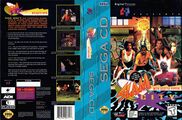 Cover
|
 Disc 1  Disc 2  Disc 3  Disc 4  Manual |
| Mega-CD, EU
|
  Cover
|
 Spinecard  Disc 1  Disc 2  Disc 3  Disc 4  Manual |
| Mega-CD, DE
|
  Cover
|
 Spinecard  Disc 1  Disc 2  Disc 3  Disc 4  Manual |
| Mega-CD, AU
|
 Cover
|
|
|
| Mega-CD, BR
|
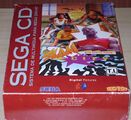 Cover
|
|
|
Mega-CD 32X version
| {{{{{icon}}}|L}}
|
Division by zero.
|
Based on
0 review
|
Slam City with Scottie Pippen
| Mega-CD 32X, US
|
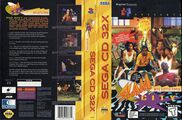 Cover
|
 Disc 1  Disc 2  Disc 3  Disc 4  Manual |
| Mega-CD 32X, EU
|
  Cover
|
 Spinecard  Disc 1  Disc 2  Disc 3  Disc 4  Manual |
Technical information
- Main article: Slam City with Scottie Pippen/Technical information.
ROM dump status
| System |
Hash |
Size |
Build Date |
Source |
Comments |
|
|
|
| ?
|
|
604,193,520
|
1994-11
|
CD-ROM (US)
|
T162035 (Disc 1)
|
|
|
|
| ?
|
|
584,516,688
|
1994-11
|
CD-ROM (US)
|
T162035 (Disc 2)
|
|
|
|
| ?
|
|
590,765,952
|
1994-11
|
CD-ROM (US)
|
T162035 (Disc 3)
|
|
|
|
| ?
|
|
558,837,552
|
1994-11
|
CD-ROM (US)
|
T162035 (Disc 4)
|
|
|
|
| ?
|
|
604,193,520
|
1995-02
|
CD-ROM (EU)
|
T-162035-50 (Disc 1)
|
|
|
|
| ?
|
|
584,163,888
|
1995-02
|
CD-ROM (EU)
|
T-162035-50 (Disc 2)
|
|
|
|
| ?
|
|
590,765,952
|
1995-02
|
CD-ROM (EU)
|
T-162035-50 (Disc 3)
|
|
|
|
| ?
|
|
558,837,552
|
1995-02
|
CD-ROM (EU)
|
T-162035-50 (Disc 4)
|
|
|
|
| ✔
|
|
604,193,520
|
|
CD-ROM (BR)
|
063636 (Disc 1)
|
|
|
|
| ✔
|
|
584,516,688
|
|
CD-ROM (BR)
|
063636 (Disc 2)
|
|
|
|
| ✔
|
|
590,765,952
|
|
CD-ROM (BR)
|
063636 (Disc 3)
|
|
|
|
| ?
|
|
558,837,552
|
|
CD-ROM (BR)
|
063636 (Disc 4)
|
|
|
|
| ?
|
|
|
|
CD-ROM (US)
|
Disc 1
|
|
|
|
| ?
|
|
|
|
CD-ROM (US)
|
Disc 2
|
|
|
|
| ?
|
|
|
|
CD-ROM (US)
|
Disc 3
|
|
|
|
| ?
|
|
|
|
CD-ROM (US)
|
Disc 4
|
|
|
|
| ?
|
|
|
|
CD-ROM (EU)
|
Disc 1
|
|
|
|
| ?
|
|
|
|
CD-ROM (EU)
|
Disc 2
|
|
|
|
| ?
|
|
|
|
CD-ROM (EU)
|
Disc 3
|
|
|
|
| ?
|
|
|
|
CD-ROM (EU)
|
Disc 4
|
|
|
|
References
- ↑ Electronic Gaming Monthly, "December 1994" (US; 1994-xx-xx), page 258
- ↑ 2.0 2.1 GamePro, "March 1995" (US; 1995-xx-xx), page 56
- ↑ 3.0 3.1 Sega Magazine, "February 1995" (UK; 1995-01-15), page 34
- ↑ 4.0 4.1 Sega Magazin, "August 1995" (DE; 1995-07-12), page 18
- ↑ File:Slam City MCD opening credits.pdf
- ↑ File:Slam City MCD credits.pdf
- ↑ File:Slamcity mcd us manual.pdf, page 20
- ↑ Next Generation, "April 1995" (US; 1995-03-21), page 60
- ↑ GamePro, "April 1995" (US; 1995-xx-xx), page 59
- ↑ Consoles +, "Février 1995" (FR; 1995-0x-xx), page 126
- ↑ Game Players, "Vol. 8 No. 3 March 1995" (US; 1995-0x-xx), page 66
- ↑ Joypad, "Février 1995" (FR; 1995-0x-xx), page 102
- ↑ MAN!AC, "03/95" (DE; 1995-02-08), page 57
- ↑ Mega Force, "Février 1995" (FR; 1995-0x-xx), page 92
- ↑ Mega Fun, "03/95" (DE; 1995-02-22), page 72
- ↑ Next Generation, "March 1995" (US; 1995-02-21), page 100
- ↑ Player One, "Février 1995" (FR; 1995-0x-xx), page 106
- ↑ Play Time, "4/95" (DE; 1995-03-08), page 108
- ↑ Sega Pro, "March 1995" (UK; 1995-01-26), page 36
- ↑ Video Games, "4/95" (DE; 1995-03-22), page 91
- ↑ VideoGames, "March 1995" (US; 1995-02-xx), page 68
- ↑ GamePro, "July 1995" (US; 1995-xx-xx), page 74
- ↑ MAN!AC, "06/95" (DE; 1995-05-10), page 71
- ↑ Mega, "August 1995" (UK; 1995-07-30), page 12
- ↑ Mega Force, "Été 1995" (FR; 1995-0x-xx), page 97
- ↑ Next Generation, "July 1995" (US; 1995-06-20), page 71
- ↑ Sega News, "Leden 1997" (CZ; 1997-xx-xx), page 33
- ↑ Video Games, "7/95" (DE; 1995-06-28), page 99
![]() or
or ![]() to try to get a clear shot around his opponent. The player can adjust the shot strength (shown as a meter next to the video) with
to try to get a clear shot around his opponent. The player can adjust the shot strength (shown as a meter next to the video) with ![]() or
or ![]() , which affects the distance that it covers. Ace shoots by holding
, which affects the distance that it covers. Ace shoots by holding ![]() to jump, then releasing
to jump, then releasing ![]() during the jump. The shot is more likely to go in and earns more respect if timed to release near the apex of the jump. Failing to release the button before landing causes the player to lose respect. Ace can exploit holes in the opponent's defense by moving all the way to the left or right of the screen and pressing
during the jump. The shot is more likely to go in and earns more respect if timed to release near the apex of the jump. Failing to release the button before landing causes the player to lose respect. Ace can exploit holes in the opponent's defense by moving all the way to the left or right of the screen and pressing ![]() to break past the opponent and perform a slam dunk. Each opponent has different cues that indicate a break opportunity. Hitting a break opportunity at its "sweet spot" results in a "Super Slam" that awards more respect. However, trying to break past the opponent when there is no opening results in having the ball stolen. There is a ten-second shot clock for the player with possession of the ball.
to break past the opponent and perform a slam dunk. Each opponent has different cues that indicate a break opportunity. Hitting a break opportunity at its "sweet spot" results in a "Super Slam" that awards more respect. However, trying to break past the opponent when there is no opening results in having the ball stolen. There is a ten-second shot clock for the player with possession of the ball.
![]() or
or ![]() to stay in front of his the opponent. If Ace leaves an opening, the opponent can run by for an easy shot. Ace can raise his hands to block with
to stay in front of his the opponent. If Ace leaves an opening, the opponent can run by for an easy shot. Ace can raise his hands to block with ![]() when the opponent is attempting a shot; after the opponent shoots, Ace can try to reject the shot with
when the opponent is attempting a shot; after the opponent shoots, Ace can try to reject the shot with ![]() . When the opponent is trying to break for a dunk, Ace can try to steal the ball with
. When the opponent is trying to break for a dunk, Ace can try to steal the ball with ![]() .
.
![]() or
or ![]() and jump for the ball with
and jump for the ball with ![]() .
.
